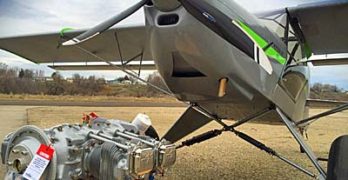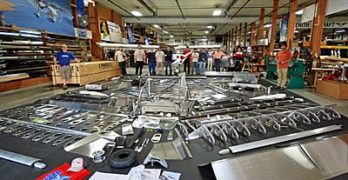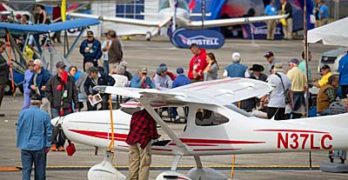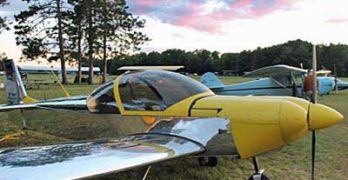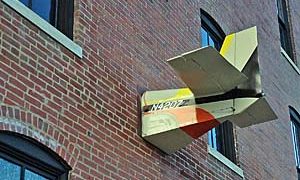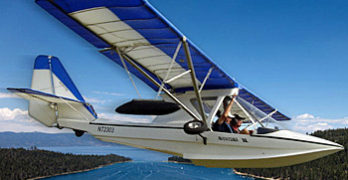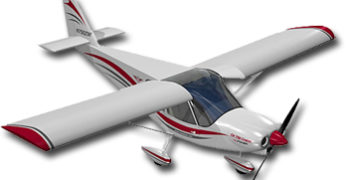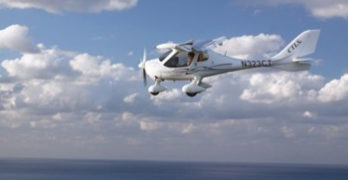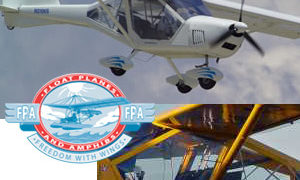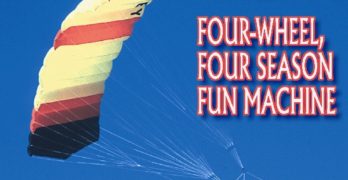In my many years in aviation, I’ve learned this about light aviation pilots: If 80-horsepower is good, then 100-horsepower is better, and even more is best of all. It explains why interest was so high when Rotax announced their new 915iS that will provide 135 horsepower. It also illustrates why the 180 horses of the Titan X-340 is succeeding in the Light-Sport Industry.
Interest from LSA producers started with CubCrafters adopting the engine several years ago. When that company’s boss, Jim Richmond, held a press conference at Sun ‘n Fun, the reception was somewhat cool. Of ten persons in the audience, only four of us were journalists. The other six (yes, 6!) people were from FAA. No wonder, perhaps, as ASTM standards at the time brought questions to mind regarding the use of such a powerful engine. Those standards have since been modified somewhat.
Indeed, the western producer instructed users that the engine could only be used at full power for takeoff or climbing, but otherwise had to be set to lower power.
Search Results for : Viking engine
Not finding exactly what you expected? Try our advanced search option.
Select a manufacturer to go straight to all our content about that manufacturer.
Select an aircraft model to go straight to all our content about that model.
Cruzer Prepared for FAA Kit Evaluation Team
Even very familiar companies like Zenith Aircraft company, part of a family light aviation empire including Zenair in Canada•, has to prepare well when FAA comes to visit. Specifically, this would be the agency’s KET or Kit Evaluation Team. When various representatives of the regulatory agency visit they use a multi-page list to assure that a kit aircraft meets the requirement that 51% of the kit is built by the owner.
Formerly called Experimental Amateur Built (or EAB), many aviators simply say the “51% rule.” In earlier times, kit aircraft were scratch built — meaning a builder secured raw materials that had to be formed and finished while referring to drawings, a potentially very lengthy process. To ease the effort and increase sales, an industry developed to sell component kits. These have become increasingly sophisticated with qualities such as match-hole construction using CNC machines.
Making it easier for a builder to assemble his or her aircraft is good, but the kit manufacturer must be able to clearly demonstrate how the owner will do 51% of the work, as required.
Weather Threat Derails Sebring for One Day
SEBRING EXPO 2016 — Opening day Wednesday started out unseasonably cool … but true to form — Florida is called the Sunshine State for good reason — the sun warmed the day nicely. Several vendors told me they thought it was the best opening day yet for the Sebring Expo.
Thursday was even more pleasant. A few of us showed sunburned faces by the end of the day, but in all, it was a second good day of the event in its 12th year (not coincidentally the same number of years for which we’ve had Sport Pilot / Light-Sport Aircraft). Several vendors reported many qualified customers and many attendees to whom I spoke seemed pleased with the depth of exhibitors and products to examine. Shows like Sebring and the Midwest LSA Expo offer more opportunity for demo flights and longer conversations with vendors who are often besieged with dense crowds at AirVenture or Sun ‘n Fun.
Corvair Power at Zenith’s Open Hangar Day
Zenith Aircraft has shipped thousands of airplane kits and have examples of Chris Heintz designs flying all over the country and around the world. The kit company run by Chris’ son Sebastien has been at it nearly a quarter century in Mexico Missouri and in my humble opinion deserves the success they’ve achieved by operating the business professionally and by serving their customers well. Two of the many ways this happens is through their Open Hangar Day event — which they’ve hosted since moving to Mexico — and by supporting just about every powerplant aimed at the light recreational aircraft market. Recently I wrote about Viking engines and I’ve often written about Rotax, Jabiru, Continental, and UL Power. One that I’ve left out of the review has been William Wynne’s Corvair-based powerplant and I am pleased to correct that oversight.
Midwest LSA Expo 2014 Highlights
The sixth annual Midwest LSA Expo just concluded. These LSA-only events offer a more intimate setting where you can speak at length with an aircraft or other product representative. They don’t offer the dense traffic of the big shows but the valued trade off is that nearly everyone who shows is interested. People came from as far as California and I witnessed many demo flights. The Mt. Vernon airport is as good as it gets for this purpose with easy access to big broad runways and plenty of open airspace. Lead by energetic Chris Collins, a team of volunteers made it work again. When the event isn’t swallowing all their time these folks have a little fun. Don’t worry about the nearby picture; TSA and Homeland Security can calm down. This was a planned promotional venture on the side of a great new restaurant called Rare, a chop house.
LSA Seaplane Companies Cluster in Central Florida
Icon Aircraft receives a high percentage of the attention paid to LSA seaplanes. They’ve worked hard on marketing and been quite successful; their Facebook page has nearly 300,000 “Likes!” Yet, as I’ve written, this is a growing subset within the LSA industry with several interesting designs already flying plus new ones to come that are really going to widen people’s eyes. However, some of that remains in the future while we have present-day success stories. If you want a seaplane you can afford and you want it soon, you have several choices, for example: Progressive Aerodyne’s SeaRey and the hot little SeaMax, both of which are SLSA approved, plus Edra Aeronautica’s Super Petrel LS, and in the world of light kits, don’t forget another longtime player, Aero Adventure. The latter Florida company recently reported news.
“Here We Come Tavares,” exclaimed a recent newsletter from Aero Adventure!
Zenith Unveils Smoother, Faster CH 750 Cruzer
At Sun ‘n Fun 2013, big kit manufacturer Zenith Aircraft debuted their new CH 750 Cruzer. Is it truly something new under the Sun (‘n Fun)? Zenith said, “While influenced by its well-known STOL predecessors — STOL CH 701 “Sky Jeep,” CH 750, and four-seat CH 801 sport utility aircraft — the CH 750 Cruzer is an all-new design.” Company president Sebastien Heintz observed that many customers do not need off-airport capability or extreme STOL (short take-off and landing) performance so his team optimized the new design for cruise and more conventional hard-surface airports while yet retaining the popular enlarged cabin features of the STOL CH 750.
Zenith‘s new Cruzer 750 sports a brand-new airfoil with a single streamlined strut. The empennage is also new with a symmetrical stabilizer and a shortened horizontal tail span. The vertical tail features a fin and rudder replacing the traditional all-moving vertical tail design of the STOL series.
LSA Industry On Life Support…ummm…Nah.
In a recent article from Flying Magazine, an editor volunteered his opinion that the Light Sport industry is on life support. There are so many good arguments to refute such a sky-is-falling assessment, it kind of makes you wonder why a respected journalist would go out of his way to attract a lot of heat in the first place … but that’s another story.
Dan Johnson makes a ton of solid rebuttal remarks in this article and in a video he did with UltralightFlyer.com — check those out.
Meanwhile, here’s a magnificent retort to the LSA-is-dead silliness: Airtime Aviation out of Tulsa, OK. Owners Tom Gutmann and his son Tom Jr. just delivered their Number 100 Flight Design airplane, a new CTLSi with a fuel injected Rotax 912 iS engine.
At Sebring I saw a bunch of installations of the new engine: it’s really catching on.
U.S. Built A-22 Valor Wins SLSA #49
After I flew the A-20 and A-22 near Aeroprakt’s Ukraine factory, I felt sure these designs would find their way to the U.S. market. Now that Sebring-based Float Planes and Amphibs (FPNA) assumed import operations from Spectrum Aircraft, you can buy planes like the great-flying A-20 Vista or the tractor engine amphib A-24 Viking. FPNA also builds an amphibious float system for trikes and sells other lines like Quicksilver ultralights and powered parachutes. *** But their newest achievement on March 31st, a couple weeks before Sun ‘n Fun 2007, was SLSA approval for the A-22 Valor. FPNA is the manufacturer of this model, purchasing the fuselage and selected other components from designer Aeroprakt in Ukraine, but building 60% of the airplane themselves including wings, avionics and panel work, engine installation, plus all plumbing and electrical. FPNA owner Shawn Okun says the Orlando MIDO office gave their approval.
Para-Ski X-treme
Taking a broader view, this is similar to other forms of aviation. One only need look at airliners. From the outside, they’re virtually identical except in size, and for good reason. Airliner designers have discovered the optimal ways to build jets that accomplish their narrowly defined mission of speedy transportation.
On the light end, essentially the same can be said for trikes, or for that matter, for most types of ultralights. Fortunately, however, the purpose of fun aircraft remains widely varied, and that forces an interesting assortment of sport flying machines.
In this month’s Ultralight Flying! Pilot’s Report, we’ll look closely at the Para-Ski powered parachute. I believe you’ll agree it stands apart from the rest.
Versatility a Goal
Para-Ski International describes their machines as “the ultimate ATV/ASV (all terrain/all season vehicle).” It may sound like a big boast, but I think you’ll see Para-Ski may be able to honestly earn the title.


